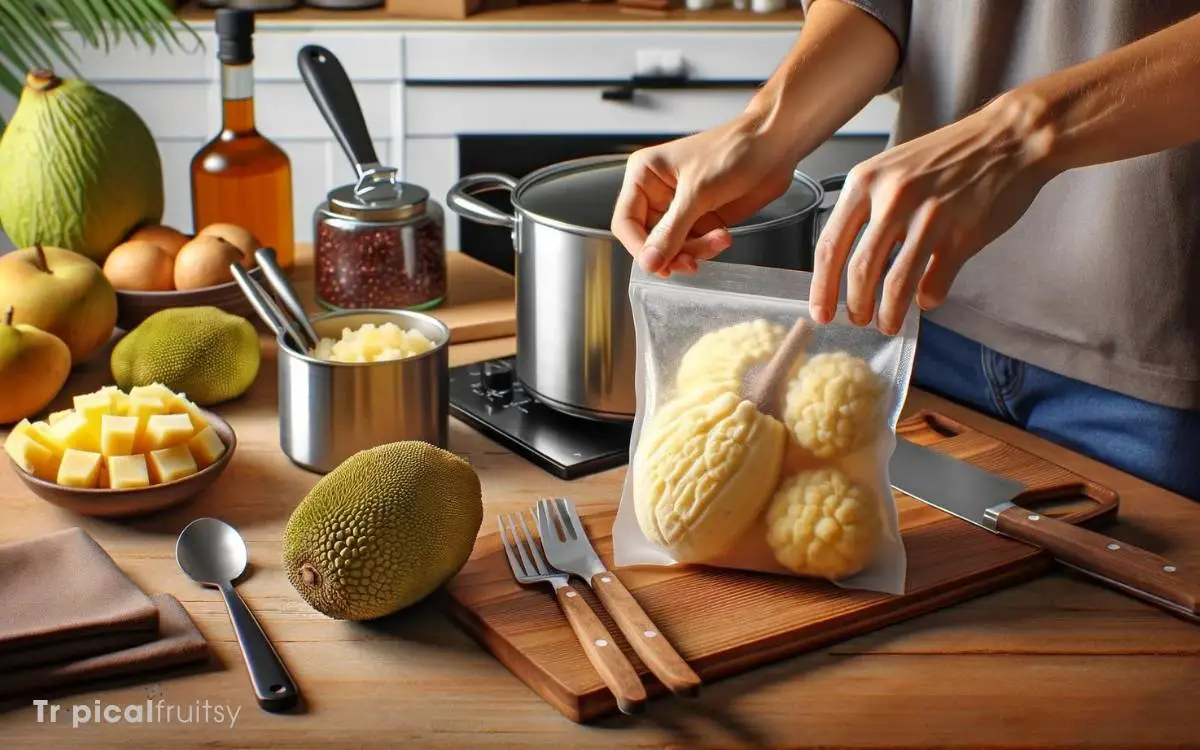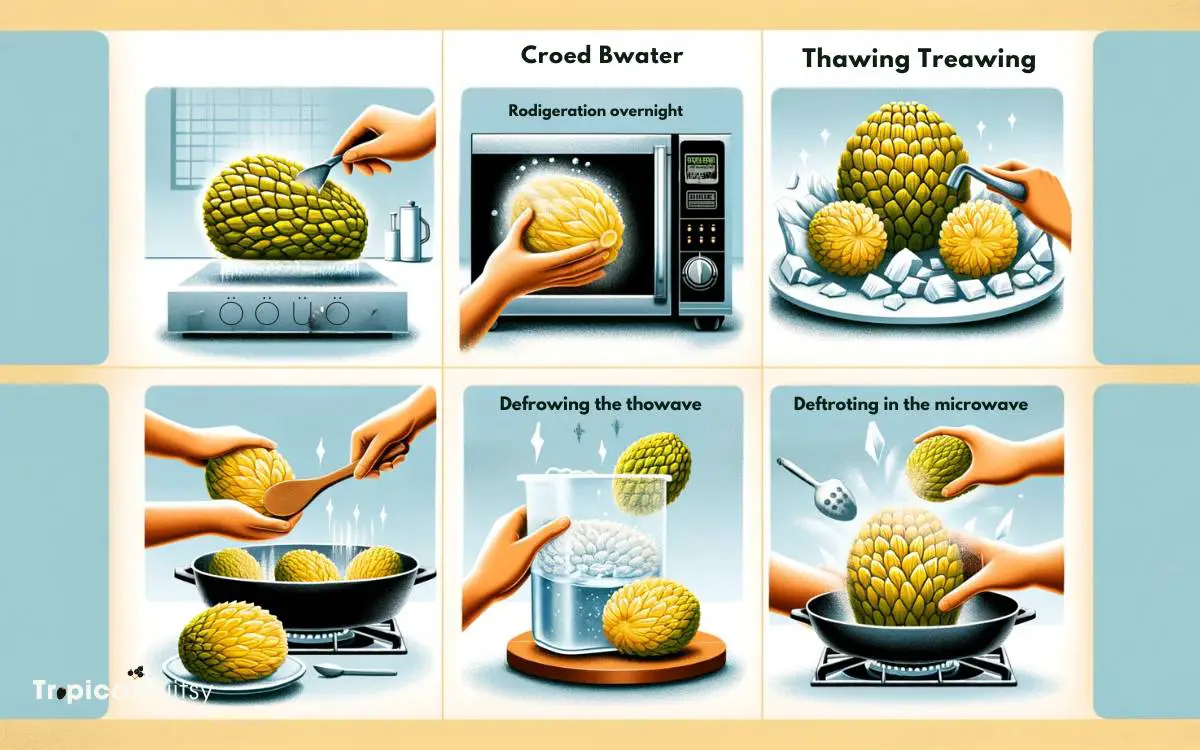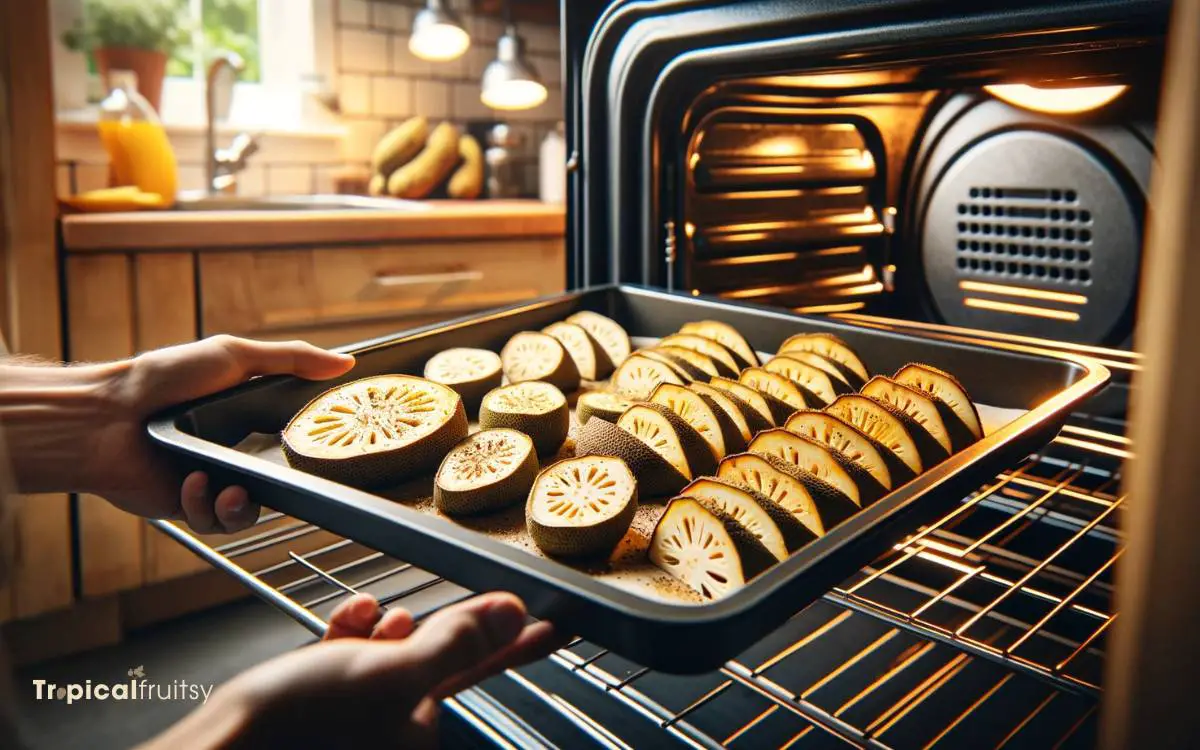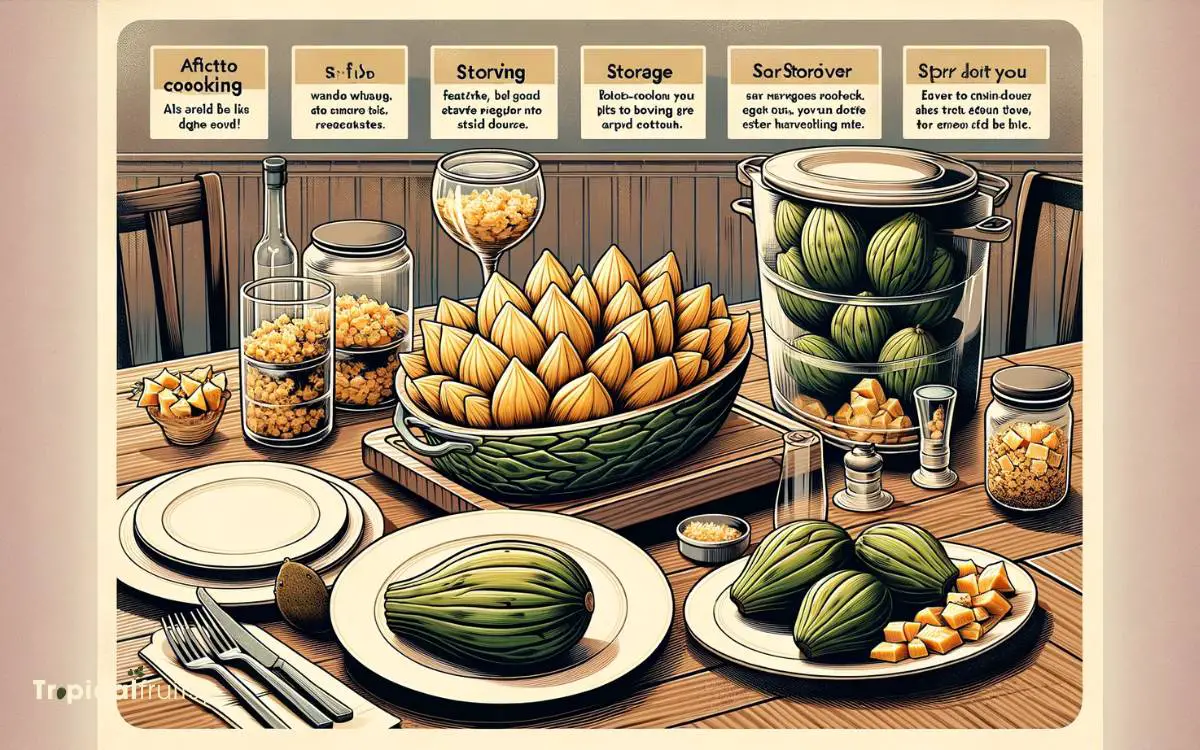How to Cook Frozen Breadfruit? 7 Easy Steps!
To cook frozen breadfruit effectively, it’s important to first defrost it to ensure it cooks evenly. Once thawed, remove the core and slice the breadfruit as desired.
You can then choose to bake, fry, boil, or steam the breadfruit, depending on your preference and the intended dish. Properly cooked breadfruit can be a nutritious and versatile addition to many recipes.
Cooking frozen breadfruit involves several important steps:
Example:
- Baking: Preheat oven to 375°F, brush slices with oil, and bake for 25 minutes.
- Frying: Cut into wedges, season, and fry until golden brown.
Incorporating breadfruit into your diet introduces a hearty and healthful element to your meals.

Key Takeaway
Understanding Frozen Breadfruit
Frozen breadfruit is a versatile ingredient that can be used in a variety of culinary applications, retaining most of the nutritional benefits and flavor of its fresh counterpart.
As a starchy food with a texture similar to that of potatoes, it serves as an excellent base for dishes that require a hearty component.
When frozen, breadfruit’s shelf life is significantly extended, making it a more accessible option for those in regions where the fruit is not native. Rich in complex carbohydrates, fiber, vitamins, and minerals, it is a nutritious addition to any meal.
Thawing it correctly ensures it maintains its integrity for further preparation. Chefs and home cooks alike should note that while its texture may be slightly altered from freezing, its utility in recipes remains unparalleled.
Step 1: Thawing Techniques

Several methods can be employed to effectively thaw breadfruit, ensuring it is ready for cooking while preserving its texture and flavor.
When selecting a thawing technique, consider the following options:
- Refrigerator Thawing: Transfer the frozen breadfruit to the refrigerator and allow it to thaw gradually, typically over several hours or overnight.
- Cold Water Thawing: Place the breadfruit in a sealed plastic bag and submerge it in cold water, changing the water every 30 minutes.
- Microwave Thawing: Use the defrost setting on your microwave, checking the breadfruit frequently to prevent cooking.
- Room Temperature Thawing: Leave the breadfruit on the countertop at room temperature for a few hours.
- Cooking from Frozen: Some recipes may accommodate cooking the breadfruit directly from frozen without prior thawing.
Each method has its merits and will vary based on time constraints and intended use.
With the breadfruit properly thawed, the next logical step is to proceed with preparing your breadfruit for your chosen recipe.
Step 2: Preparing Your Breadfruit

Prior to cooking, it is essential to properly prepare your thawed breadfruit to ensure optimal texture and flavor. This preparation includes the crucial step of pre-cook peeling, which allows for a more uniform cooking process.
Attention to this detail is imperative for those seeking to achieve the best culinary results with their frozen breadfruit dishes.
Thawing Techniques
Before cooking, it is essential to properly thaw frozen breadfruit to ensure even cooking and optimal texture. Employing the right thawing technique not only preserves the fruit’s integrity but also enhances its flavor profile.
Here are some effective methods:
- Refrigerator Thawing: Transfer the breadfruit from the freezer to the refrigerator and allow it to thaw slowly, typically overnight.
- Cold Water Thawing: Submerge the breadfruit in cold water, changing the water every 30 minutes to maintain a safe temperature.
- Room Temperature Thawing: Leave the breadfruit on the kitchen counter for a few hours, although this method is not recommended for large pieces.
- Microwave Thawing: Use the defrost setting on your microwave for a quick thaw, but be cautious to avoid cooking the edges.
- Natural Thawing: Plan ahead for a natural thaw by moving the breadfruit to a cooler environment, such as a basement, to gradually come to room temperature.
Pre-Cook Peeling
Once the breadfruit is thoroughly thawed, the next step involves carefully peeling the fruit to prepare it for cooking.
Begin by placing the breadfruit on a stable cutting board. Using a sharp, preferably serrated knife, slice off the stem and base to create flat surfaces, stabilizing the fruit for peeling.
Gently score the skin lengthwise, taking care not to cut too deeply into the flesh. Proceed to remove the skin in sections, following the natural divide of the breadfruit’s lobes. It is essential to eliminate all of the skin, as it can be tough and inedible.
Discard the peeled skin appropriately. Once peeled, the breadfruit is ready for further culinary applications, whether it be roasting, frying, or boiling.
Step 3: Cooking Methods Overview

Cooking frozen breadfruit requires an understanding of appropriate oven temperatures and effective thawing techniques.
To ensure optimal texture and flavor, one must recognize the specific conditions under which breadfruit best transitions from a frozen state to a fully cooked state.
We will now review these essential methods, providing clear guidelines for both oven baking and proper thawing of frozen breadfruit.
Oven Baking Temperatures
How should one adjust the oven temperature when baking frozen breadfruit to ensure even cooking and optimal texture? The key is to use a moderate heat that will cook the breadfruit thoroughly without burning the exterior.
Here are some guidelines to follow:
- Preheat your oven to 375°F (190°C) for a conventional oven, or 350°F (175°C) if using a convection oven.
- Place the frozen breadfruit on a baking sheet lined with parchment paper.
- Bake for approximately 20-30 minutes, depending on the size of the breadfruit pieces.
- Halfway through, turn the breadfruit to ensure even browning and cooking.
- Test for doneness by inserting a fork; it should penetrate with little resistance.
Understanding the correct oven temperatures sets the stage for successful preparation; next, we’ll explore the importance of thawing techniques.
Thawing Techniques
Before delving into specific cooking methods, it is essential to address the process of thawing frozen breadfruit to ensure even cooking and preserve its texture.
Thawing breadfruit properly is a critical step that can significantly impact the quality of the final dish.
The most reliable method is to transfer the frozen breadfruit to the refrigerator and allow it to thaw gradually, a process that can take several hours or overnight, depending on the size of the pieces.
For a quicker method, placing the breadfruit in a sealed plastic bag and submerging it in cold water can expedite thawing while maintaining safety.
It is imperative to avoid using hot water or microwaving, as these can lead to uneven thawing and textural degradation. With the breadfruit adequately thawed, we can now focus on baking breadfruit perfectly.
Step 4: Baking Breadfruit Perfectly

Baking frozen breadfruit to perfection involves preheating your oven to the appropriate temperature and preparing the fruit with a light coating of oil or butter.
To ensure optimal results, consider the following key points:
- Preheat the oven to 400°F (200°C) for even cooking.
- Slice the breadfruit into even pieces to promote uniform baking.
- Season according to preference, with options including sea salt, garlic powder, or herbs.
- Arrange the slices on a baking sheet in a single layer to prevent overlap and ensure proper heat circulation.
- Bake for 20-30 minutes, or until golden brown and tender, flipping the slices halfway through the cooking process.
Employing these techniques will yield a deliciously baked breadfruit, with a satisfying texture and enhanced natural flavors.
Step 5: Frying for Crispiness

Transitioning from the oven to the stovetop, frying frozen breadfruit unlocks a crispy exterior while maintaining a soft interior.
To achieve this texture, begin by heating a generous amount of oil in a deep skillet or frying pan over medium-high heat. Ensure the oil is hot enough to sizzle upon contact with the breadfruit.
Carefully add the frozen slices to the pan without overcrowding, which can lead to uneven cooking and sogginess. Fry each side until a golden-brown crust forms, typically taking a few minutes per side.
Use tongs to safely flip the slices, ensuring all sides are equally crisped. Once done, transfer the breadfruit to a wire rack or paper towel-lined plate to drain excess oil before serving.
This method ensures a delightful contrast of textures, ideal for a satisfying meal or snack.
Step 6: Boiling and Steaming Tips

For those seeking a softer texture, boiling and steaming are effective methods for preparing frozen breadfruit. These techniques ensure that the breadfruit cooks evenly and retains its nutritional value.
Here are some key tips to consider:
- Thawing: Gradually thaw frozen breadfruit before cooking to ensure even heat distribution.
- Water Level: For boiling, immerse breadfruit in enough water to cover it, while for steaming, ensure the water does not touch the fruit.
- Cooking Time: Adjust boiling or steaming time depending on the size of the breadfruit pieces, typically 20-30 minutes.
- Seasoning: Infuse the water with salt or herbs for added flavor.
- Texture Check: Pierce with a fork to assess doneness; the breadfruit should be tender but still hold its shape.
These strategies will help you master boiling and steaming frozen breadfruit, preserving its delicate taste and texture.
Can I Use Frozen Breadfruit to Eat in the Same Way I Cook it?
Yes, you can use frozen breadfruit to eat in the same way you cook it. To enjoy it, simply thaw it out and then use it in your favorite breadfruit recipes. There are many delicious ways to prepare and enjoy frozen breadfruit. How to eat breadfruit is up to your own culinary creativity.
Step 7: Serving and Storage Suggestions

Once cooked, the breadfruit can be served immediately or stored properly to maintain its freshness for future use.
It is paramount to allow the breadfruit to cool completely before any form of storage to prevent moisture buildup that could lead to spoilage.
Refrigerate the cooked breadfruit in airtight containers; it typically remains fresh for up to five days. For longer preservation, freezing is advisable.
Wrap the breadfruit tightly in plastic wrap or aluminum foil, then place it in freezer bags, expelling as much air as possible before sealing. Properly frozen, the breadfruit can last for several months.
When reheating, ensure it is thoroughly warmed to restore its texture and flavor, which is best achieved by using an oven or stovetop.
Conclusion
The culinary journey with frozen breadfruit culminates in a symphony of textures and flavors. Whether baked to golden perfection, crisped in a sizzling pan, or tenderly boiled and steamed, this versatile fruit emerges as a delectable masterpiece.
Proper storage and serving techniques ensure the essence of breadfruit is captured and savored.
The adept handling of this tropical bounty promises a gastronomic experience that dances gracefully on the palate.






